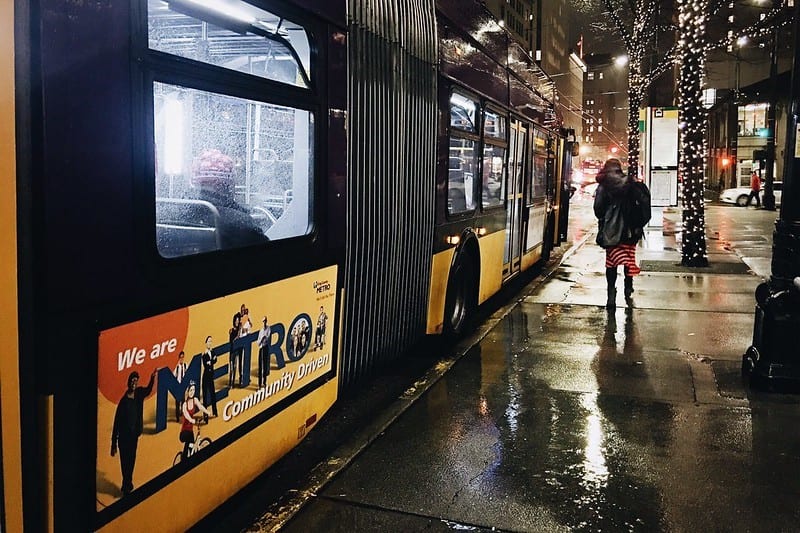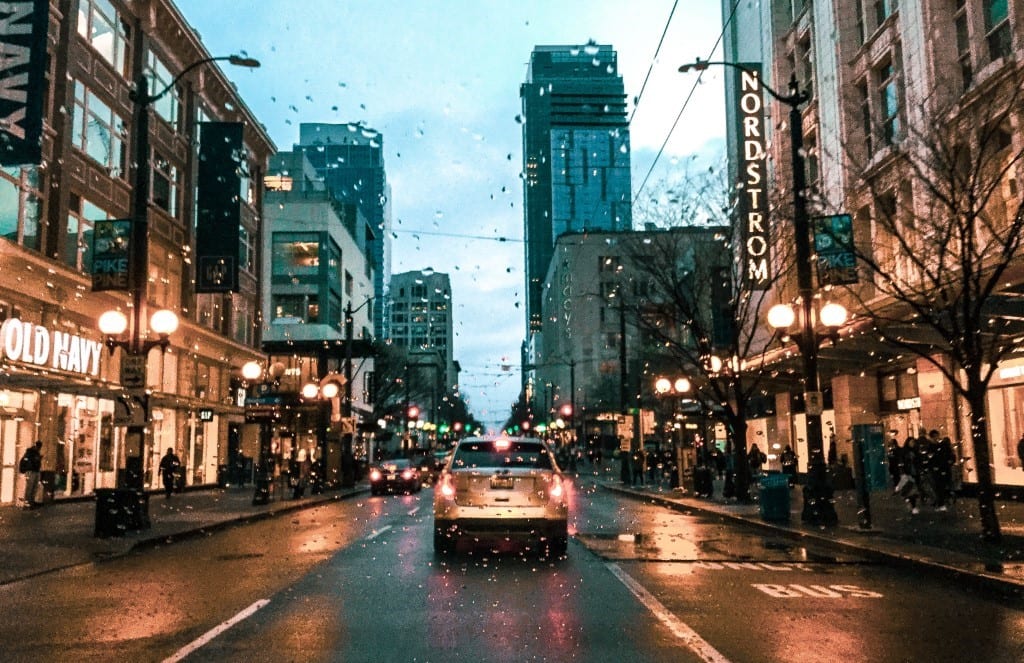 Seattle at sunset. Photo Credit: Eric Zhang on Unsplash
Seattle at sunset. Photo Credit: Eric Zhang on Unsplash Summary
- 2020 is about to get darker (literally): Daylight Savings ends November 1. Now, more than ever, we need to be looking out for each other. Whether you’re walking, rolling, biking, driving, or taking public transit – safety can be a collective effort when we keep an eye out for each other and follow the rules.
- As we head into these darker days, we’ve pulled together some quick reminders and tips to stay safe.
- While we’ve focused this post on individual actions we can each take as we get around, we also know how critical street design and system changes are to achieving our safety goals.
- Remember that no matter how people are getting around (whether by car, transit, on foot, wheelchair, or bike) we’re all people. We’re sons, daughters, mothers, fathers, grandparents, friends, and neighbors. Let’s look out for each other and help Seattle reach our Vision Zero goal of ending traffic deaths and serious injuries by 2030.
2020 is getting darker (literally). Daylight Savings ends November 1. Now, more than ever, we need to be looking out for each other.

Daylight Savings ends Sunday, November 1. On October 31, the sun will set at 5:52 PM. But, on November 1, the sun will set at 4:50pm. Collisions often increase as we head deeper into the fall, when there’re fewer hours of sunlight and more rain. Darkness doesn’t mean that things stop moving, but it does mean that we have to double down on looking out for each other as we get around. October is also National Pedestrian Safety Month.
Whether you’re walking, rolling, biking, driving, or using public transit – safety is a collective effort when it comes to keeping an eye out for each other and following the rules.

We talk about Vision Zero a lot on our blog, and we’ll say it again: zero is the only acceptable number of traffic-related fatalities. Vision Zero is Seattle’s plan to end traffic deaths and serious injuries on city streets by 2030. We all have a role to play in getting there, and together, we believe we’ll get there.
As we head into these darker days, here are some quick reminders and tips to stay safe:
If you’re driving, stay alert, slow down, and yield to people NOT in cars or vehicles.

- Stop for people walking or rolling. Recognize that every intersection is a legal crossing, so look out at each intersection, and stop for people looking to cross.
- Slow down. Remember that the speed limit in school zones and on all residential streets is 20 MPH. Most arterials (streets with a yellow line down the middle) are 25 MPH. Take it slow on our streets. It’s simple – the faster you drive, the longer it takes to slow down, and the more severe a crash could be. Plan ahead and give yourself plenty of time to reach your destination.
- Put down your phone. October is Distracted Driving Awareness Month, but really it’s always a good time to remind people that it is against the law to use hand-held electronic devices (cell phones, tablets, laptops, etc.) while driving. This law is critical in the effort to end traffic-related deaths.
One chilling fact from the U.S. Department of Transportation: “At any given moment across America, approximately 660,000 drivers are using or manipulating electronic devices while driving, a number that has held steady since 2010. Distracted driving has become a deadly epidemic on America’s roadways.”
Remember: Most crashes are preventable (they’re not accidents). Your choices matter.
While people walking have the right of way, it’s still critical to be aware and attentive, especially as we head into these darker months:

- When crossing, look both ways and over your shoulder (for turning vehicles). If possible, make eye contact with drivers before crossing the street.
- Pay attention and put your phone down before you cross. Even while walking, rolling, or biking – always keep your eyes and ears on the road.
- Light Up Your Trip! Darker, rainier days don’t mean your walking, rolling, biking, scootering, and bus trips have to stop – but they do need to be safe, and there are some ways to make them a little brighter – literally and figuratively!
- If you’re biking, make sure you have a working front light and rear reflector (or better yet, a rear red light).
- To get yourself prepared for active trips, round up the winter gear that’s scattered around your home and put it right near your door for easy access when you’re leaving the house for a trip (think: hats and earmuffs, gloves, rain jacket, your most durable shoes, umbrella, reflective clothing, wool socks, and/or camping headlamps!)
- Together with Commute Seattle, we’ve developed some suggestions to brighten things up in other ways! Some favorites: start listening to a comedy podcast on your walk or commute; if you have a dog, get them a raincoat, too, so you both can enjoy longer walks, or try something new like riding a scooter to the bus stop!
- When you’re safely bundled up, explore neighborhood businesses you’ve never visited with this map, which helps you identify small businesses and restaurants in your area.

In partnership with Commute Seattle, we are offering a giveaway via social media to help you gear up for the darker, colder seasons. For a chance to win a $100 gift card for active commute attire, share how you plan to brighten up your trips and use the hashtag #LightUpYourTrip on social media. You can also submit your story here.
While we’ve focused this post on individual actions we can each take as we get around, we also know how critical street design and system changes are to achieving our safety goals.
Here are a few recent and current projects that will help us get there:

- Our redesign of a section of NE 65th St, which led to fewer collisions and injuries, and no fatal or severe injury collisions, in 2019.
- Our 12th Ave S project, beginning this month, aims to reduce vehicular speed on 12th Ave S and reduce crashes that injure people walking, rolling, and biking.
- Improvements in Lake City, including new crosswalks and crossing signals, new sidewalks, and improved curb ramps to provide better sidewalk connections for people of all abilities.
- Reducing speed limits to 25 MPH on over half of our streets citywide, with more to come.
- Completing our pedestrian-first crosswalk safety goal six months early, while advancing a new policy to give people more time to cross the street
The days may be getting darker, but we’re in this together. Remember that no matter how people are getting around (whether by car, transit, foot, wheelchair, or bike), we are all people – sons, daughters, mothers, fathers, grandparents, friends, and neighbors.

Let’s look out for each other and help Seattle reach our Vision Zero goal of ending traffic deaths and serious injuries by 2030.